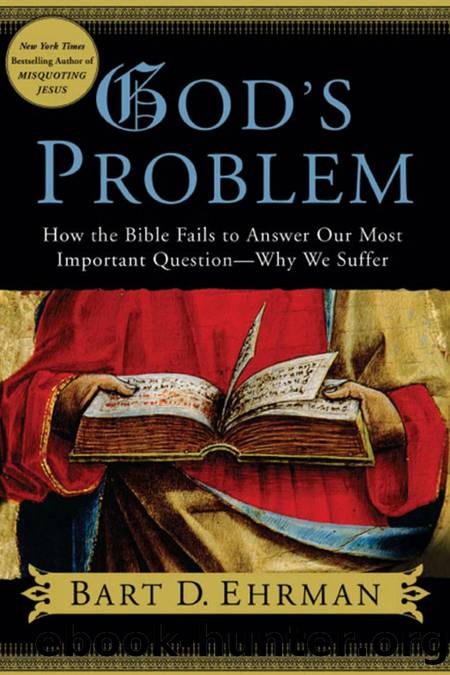God's Problem by unknow

Author:unknow
Language: eng
Format: mobi
Published: 0101-01-01T00:00:00+00:00
Chapter Four: The Consequences of Sin
1. Josephus, Jewish Wars, bk. 6, ch. 4.
2. See note 9 in chapter 3.
3. See note 9 in chapter 1.
Chapter Five: The Mystery of the Greater Good: Redemptive Suffering 1. See Bart D. Ehrman, The New Testament: A Historical Introduction to the Early Christian Writings, 3d ed. (New York: Oxford Univ. Press, 2004), ch. 9.
2. See Ehrman, New Testament, 288â91.
3. See John Collins, The Scepter and the Star: The Messiahs of the Dead Sea Scrolls and Other Ancient Literature (New York: Doubleday, 1995).
4. Thus 2 Corinthians 11:22â29; see the discussion in chapter 4.
Chapter Six: Does Suffering Make Sense? The Books of Job and Ecclesiastes 1. As you might imagine, the literature on Job is vast. For an introduction to some of the most important critical issues, see the discussions and bibliographies in Collins, Hebrew Bible, 505â17; Coogan, Old Testament, 479â89; and James Crenshaw, âJob, Book of,â in Anchor Bible Dictionary, 3:858â68.
2. See the works cited in chapter 6, note 1.
3. See the works cited in chapter 6, note 1.
4. This, of course, would have been impossible, as my reader Greg Goering has pointed out to me, since Ecclesiastes was written later.
5. See the discussions of Ecclesiastes in Collins, Hebrew Bible, 518â27; Coogan, Old Testament, 490â95; and James Crenshaw, âEcclesiastes, Book of,â in Anchor Bible Dictionary, 2:271â80.
Notes 283
Chapter Seven: God Has the Last Word: Jewish-Christian Apocalypticism 1. There is an abundant literature on apocalypticism (and the literary genre
âapocalypseâ). See the discussions and bibliographies in Adela Yarbro Collins,
âApocalypses and Apocalypticism,â in Anchor Bible Dictionary, 1:279â92, and in John Collins, The Apocalyptic Imagination: An Introduction to the Matrix of Christianity (New York: Crossroad, 1984).
2. For an introduction to the Maccabean period, see Shaye Cohen, From the Maccabbees to the Mishnah (Philadelphia: Westminster, 1987).
3. See John Collins, âDaniel, Book of,â in Anchor Bible Dictionary, 2:29â37; Collins, Hebrew Bible, 553â71; and Coogan, Old Testament, 536â43.
4. For other interpretations, including the view that the âone like a son of manâ is an angelic figure who receives the kingdom on behalf of Godâs chosen people, see the studies cited in the previous note.
5. For this understanding of Jesus as an apocalypticist, see the following books (which represent a tiny fraction of the scholarly literature on the historical Jesus but agree with the majority view that Jesus was an apocalypticist): Dale Allison, Jesus of Nazareth: Millenarian Prophet (Minneapolis: Fortress, 1998); Bart D. Ehrman, Jesus: Apocalyptic Prophet of the New Millennium (New York: Oxford Univ. Press, 1999); Paula Frederiksen, Jesus of Nazareth, King of the Jews: A Jewish Life and the Emergence of Christianity (New York: Knopf, 1999); John Meier, A Marginal Jew: Rethinking the Historical Jesus (New York: Doubleday, 1991â ; three volumes have so far appeared); E. P.
Sanders, The Historical Figure of Jesus (London: Penguin, 1993).
6. In the Gospel narratives, Jesus uses the phrase âSon of Manâ to refer to himself. In my book Jesus: Apocalyptic Prophet of the New Millennium, I give the arguments that have convinced many scholarsâmyself includedâthat the
Download
This site does not store any files on its server. We only index and link to content provided by other sites. Please contact the content providers to delete copyright contents if any and email us, we'll remove relevant links or contents immediately.
What Is the Gospel? (Foreword by D. A. Carson) by Greg Gilbert(952)
Daily Strength: Devotions for Bible Believing Study by Douglas Stauffer & Andrew Ray & Rick Quatro(855)
Christian Ethics by Wilkens Steve;(766)
The Practice Is the Path by Tias Little(758)
New Morning Mercies by Tripp Paul David(756)
Jesus in Me by Anne Graham Lotz(720)
Veritas: A Harvard Professor, a Con Man and the Gospel of Jesus's Wife by Ariel Sabar(693)
Cleaning Up Your Mental Mess by Dr. Caroline Leaf(675)
Greatest Mystery in the World by Og Mandino(608)
The Creative Call by Janice Elsheimer(530)
No More Christian Nice Guy by Paul Coughlin(529)
Our Appointment with Life by Thich Nhat Hanh(527)
2084 by John C. Lennox(509)
Monastic Archaeology by Unknown(495)
This One Wild and Precious Life by Sarah Wilson(495)
Jesus--Awesome Power, Awesome Love (Discover 4 Yourself® Inductive Bible Studies for Kids) by Kay Arthur(494)
The Duties of Parents by J.C. Ryle(470)
The Tale of the Tardy Oxcart (Swindoll Leadership Library) by Swindoll Charles R(447)
A Closer Talk with God: Scriptural Prayers for Women by Kim Trujillo(434)
